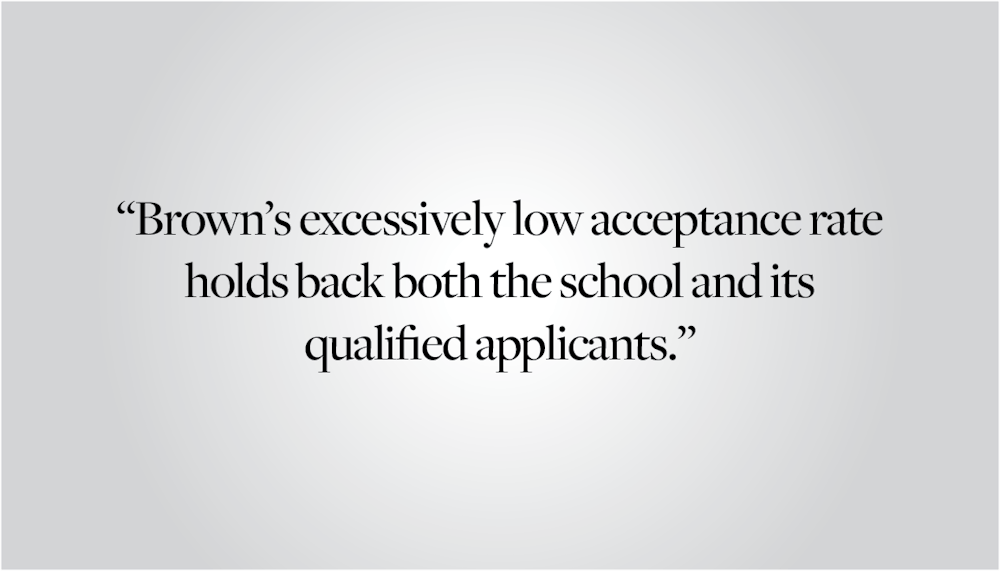Let’s go through a quick exercise — I will describe two students and you decide which one deserves to get into Brown. Student A scored a 1550 on her SAT, earned a 3.95 grade point average and scored high marks on 11 Advanced Placement tests. Her extracurriculars included founding an accounting club, participating in about 30 school plays and working multiple jobs throughout high school. Student B scored a 1560 on the SAT and took 12 AP classes. Outside of his coursework, Student B was president of his school’s student government, a senior Boy Scout leader and a prolific volunteer, logging more than 2,000 volunteer hours. So, which one of them deserved to get into Brown? In my opinion, the answer is quite obvious: both students should have been accepted.
Every year, Brown gets thousands of applicants with impressive qualifications and foolishly rejects most of them. These hard-working, high-achieving and passionate students miss out on the opportunities that Brown offers while Brown misses out on the chance to build a larger community of talented individuals. The University’s excessively low acceptance rate holds back both the school and its qualified applicants, so Brown should significantly increase the number of students it admits.
The selectivity of modern-day college admissions processes causes students to fixate on getting into elite institutions at the expense of their real passions. But it is unrealistic to expect teenagers to have fully-fledged plans for the future and world-class achievements ready to put on a résumé. Nonetheless, this pressure stresses applicants and compels them to adopt an overly competitive mindset toward their peers. A 2014 survey of more than 10,000 middle and high school students asked them what mattered most: high individual achievement, happiness or caring for others — 80% picked high individual achievement while only 22% said caring for others. Ivy league universities like Brown are not helping this phenomenon as they encourage this cutthroat culture in their admissions processes. By increasing its acceptance rate and becoming less competitive, Brown can discourage this stressful and unnecessary competition. Getting into Brown will no longer partially be about winning the college admissions game but rather a simple opportunity for a larger group of curious, passionate students to continue learning and focusing on their passions.
There are many reasons why people might argue against raising Brown’s acceptance rate, but they’re all easily rebutted.
The clearest objection people may have to taking in thousands more students is that Brown as it is today simply cannot house many more people. Dormitories, dining halls and other pillars of campus life like the Nelson Fitness Center have already faced issues with excessive crowding. However, if the University allocated appropriate resources to these issues, they would be solvable. Brown has a $6.5 billion endowment that has nearly tripled in size over the past 15 years. It should designate a larger endowment payout for operational purposes, such as building new dormitories and dining halls.
With the potential for expansion comes the question of whether or not the University should further encroach on the greater Providence community. Brown’s expansion is likely to help the Providence community. Children who grow up near college towns are unusually likely to become successful – even if they have little affiliation with the University. Simply being near a hub of creativity and innovation can provide them a leg up in their lives and education. With a higher acceptance rate, Brown could also enroll more students from Rhode Island, allowing the University to become a more integrated part of the community instead of continuing to impose upon it. In the meantime, added tuition dollars could flow back into the city’s pocket through renegotiated memorandums of understanding and direct financial support for the city’s educational landscape.
Yet another counterargument for increasing Brown’s acceptance rate is that the school needs to maintain its prestige. Supposedly, being selective shows the world that Brown only accepts the best and educates them better than anywhere else. To disprove this, we only need to take a quick look at the University of Toronto, which U.S. News ranks as the 18th-best university in the world — over 100 spots higher than Brown — despite a 43% acceptance rate. The University of Toronto is able to educate far more students, including future Canadian prime ministers, than Brown — all with a “measly” $3.2 billion endowment.
Brown must accept as many qualified students as possible. The University will benefit from having a larger — but equally exceptional — pool of innovators and thinkers. And the deserving students who are rejected every year will not be left to wonder why their dream school decided that they are not good enough.
Now let’s go back to Student A and Student B. Which one do you think was actually accepted? Maybe Student A, with her fantastic grades and impressive extracurriculars. Or perhaps Student B — he took many AP classes, had an excellent SAT score and worked hard to support his community. The sad truth is that both of these students were rejected from Brown — and both of them should be here on College Hill.
Ben Aizenberg ’26 can be reached at benjamin_aizenberg@brown.edu. Please send responses to this opinion to letters@browndailyherald.com and other op-eds to opinions@browndailyherald.com





